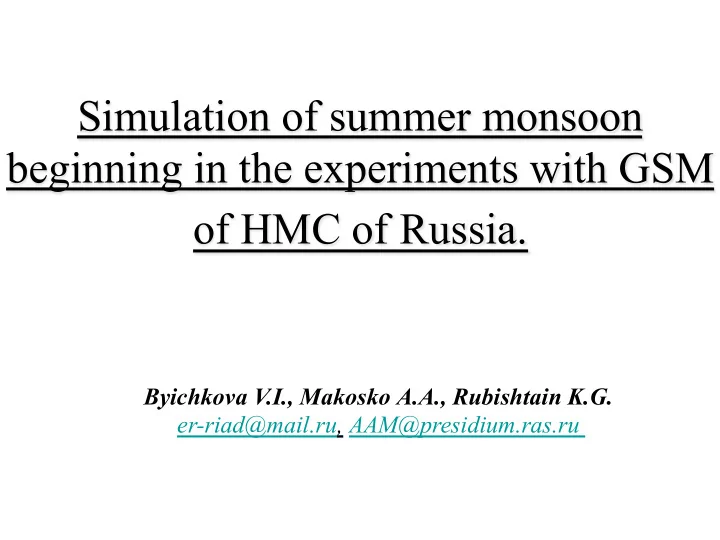

Simulation of summer monsoon beginning in the experiments with GSM of HMC of Russia. Byichkova V.I., Makosko А . А ., Rubishtain K.G. er-riad@mail.ru, AAM@presidium.ras.ru
Work is devoted to estimation the adequacy of reproduced early monsoon circulation. The aim of presented work is to estimation the impact of accounting anomalies in the gravitational field of the reproduction model atmospheric general circulation Hydrometeorological Russia started the Asian monsoon circulation.
Monsoon - "macroscale regime of air currents over large parts of the earth's surface, characterized by high repeatability of a prevailing wind direction during winter and summer season, but with a sharp change of the prevailing direction from season to season. Monsoons are due to the fact that the equatorial depression and its associated convergence zone during the year shift to the southern hemisphere, then in the north “ (Hromov). . Monsoon criteria were considered: • Changing the sign of divergence, and subsequent emergence of stable negative values. This criterion reflects the change processes in the atmospheric circulation over the monsoon region. • Date of heavy rainfall. • Date of transition anomalies of kinetic energy at 100 mJ.
Gravity anomalies are large in nature with the main features of Greenland, in the Asian monsoon and the Himalayas. Therefore, consideration of these features may affect the quality of the reproduction timing of the monsoon. Multiple description of numerical experiments Three experiments "M3", "M11" and "E" by the AMIP protocol from 1979 to 1988 with GMS of Hydrometeorological Centre of Russia were realized. In the experiment «M3» values of the tangential field components of gravity in the grid model was chosen from the original grid. It was adopted by their constancy of the vertical coordinate. In the experiment "M11" values of the tangential field components are obtained by adding the average values of the model grid cell with high-frequency component. The results of these experiments were compared with the standard and the "white" experiment "E", in which the influence of inhomogeneous gravity field is neglected. As a standard used: data reanalysis NCEP / NCAR - when we analyzing the characteristics of circulation, and the GPCP data - the analysis of precipitation.
1. Criterion monsoon beginning - Changing the sign of divergence, followed by the establishment of stable negative values. 150 100 Horisontal divergence*1000000, 1/s 50 0 -50 -100 -150 September-December January - March April-August -200 Реанализ М 3 М 11 Е For all 10 years dates monsoon beginning identified by the date of change the sign of divergence from positive to negative with a subsequent steady persistence of negative values
150.00 18.00 2. Criterion monsoon beginning - rainfall exceeding 10 mm. 16.00 100.00 14.00 Horisontal divergence*1000000, 1/s 50.00 12.00 0.00 GPCP , мм 10.00 8.00 -50.00 6.00 -100.00 4.00 -150.00 2.00 -200.00 0.00 GPCP Reanalys М 3 М 11 Е 350 3. Criterion monsoon beginning - kinetic energy in the lower troposphere 300 250 К inetic energy, мД j 200 150 100 50 0 September-December January - March April-August -50 Реа nalys М 3 М 11 E
Conclusions and results: • Monsoon beginning defined as the time when the sustained negative divergence, calculated from experiments with a modified gravitational field of the M3 and M11, were closer to the “ standart" dates. • From the dates of the rainy season, the minimum difference with the standard in the experiment - M11. • The kinetic energy for the level of 850 hPa increases by "monsoon" months. Experiment M3 is closest to the dates of increasing energy in the summer. • Accounting anomalies of the gravitational field leads to better play the model the timing of the monsoon.
Thank you for attention. Waiting for the question near the poster.
Recommend
More recommend